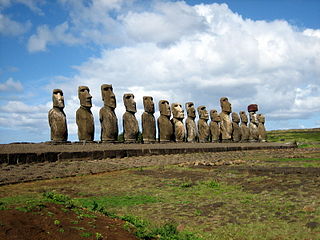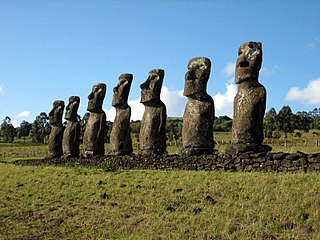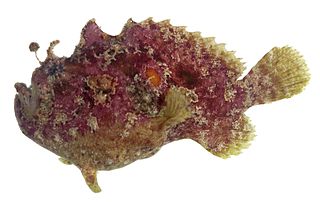
Easter Island is an island and special territory of Chile in the southeastern Pacific Ocean, at the southeasternmost point of the Polynesian Triangle in Oceania. The island is most famous for its nearly 1,000 extant monumental statues, called moai, which were created by the early Rapa Nui people. In 1995, UNESCO named Easter Island a World Heritage Site, with much of the island protected within Rapa Nui National Park.

Moai or moʻai are monolithic human figures carved by the Rapa Nui people on Rapa Nui in eastern Polynesia between the years 1250 and 1500. Nearly half are still at Rano Raraku, the main moai quarry, but hundreds were transported from there and set on stone platforms called ahu around the island's perimeter. Almost all moai have overly large heads, which comprise three-eighths the size of the whole statue. They also have no legs. The moai are chiefly the living faces of deified ancestors.

The Rapa Nui are the indigenous Polynesian peoples of Easter Island. The easternmost Polynesian culture, the descendants of the original people of Easter Island make up about 60% of the current Easter Island population and have a significant portion of their population residing in mainland Chile. They speak both the traditional Rapa Nui language and the primary language of Chile, Spanish. At the 2017 census there were 7,750 island inhabitants—almost all living in the village of Hanga Roa on the sheltered west coast.

Frogfishes are any member of the anglerfish family Antennariidae, of the order Lophiiformes. Antennariids are known as anglerfish in Australia, where the term "frogfish" refers to members of the unrelated family Batrachoididae. Frogfishes are found in almost all tropical and subtropical oceans and seas around the world, the primary exception being the Mediterranean Sea.

The spotfin frogfish, also known as the big-spot angler, coin-bearing frogfish, darkspot frogfish, ocellated angler, ocellated fringed fishing frog, opulent frogfish, spotfin angler or white-finger anglerfish, is a species ray-finned fish belonging to the family Antennariidae, the frogfishes. The spotfin frogfish is found in scattered locations the eastern Atlantic, Indian and western Pacific Oceans.

Rapa Nui National Park is a national park and UNESCO World Heritage Site located on Easter Island, Chile. Rapa Nui is the Polynesian name of Easter Island; its Spanish name is Isla de Pascua. The island is located in the southeastern Pacific Ocean, at the southeastern extremity of the Polynesian Triangle. The island was taken over by Chile in 1888. Its fame and World Heritage status arise from the 887 extant stone statues known by the name "moai", whose creation is attributed to the early Rapa Nui people who inhabited the island starting between 300 and 1200 AD. Much of the island has been declared as Rapa Nui National Park which, on 22 March 1996, UNESCO designated a World Heritage Site under cultural criteria (i), (iii), & (v). Rapa Nui National Park is now under the administrative control of the Ma´u Henua Polynesian Indigenous Community, which is the first autonomous institute on the island. The indigenous Rapa Nui people have regained authority over their ancestral lands and are in charge of the management, preservation and protection of their patrimony. On the first of December 2017, the ex-President Michelle Bachelet returned ancestral lands in the form of the Rapa Nui National Park to the indigenous people. For the first time in history, the revenue generated by the National Park is invested in the island and used to conserve the natural heritage.

Ahu Akivi is a particular sacred place on the Chilean island of Rapa Nui, looking out towards the Pacific Ocean. The site has seven moai, all of equal shape and size, and is also known as a celestial observatory that was set up around the 16th century. The site is located inland, rather than along the coast. Moai statues were considered by the early people of Rapa Nui as their ancestors or Tupuna that were believed to be the reincarnation of important kings or leaders of their clans. The Moais were erected to protect and bring prosperity to their clan and village.

The psychedelic frogfish is a yellow-brown or peach colored frogfish named for its pink and white stripes arranged in a fingerprint pattern. The fish is from waters near Ambon Island and Bali, Indonesia.

Antennatus is a genus of frogfishes. The last species was described in 2001.

Abantennarius sanguineus, the bloody frogfish or sanguine frogfish, is a species of marine ray-finned fish belonging to the family Antennariidae, the frogfishes. The sanguine frogfish is found in the eastern Pacific Ocean.
The scalemouth jobfish, also known as the scalemouth snapper, is a species of marine ray-finned fish, a snapper belonging to the family Lutjanidae. It is native to the Pacific Ocean. This species is the only known member of its genus.

Randall's frogfish is a marine fish belonging to the family Antennariidae, the frogfishes.
Abantennarius drombus, freckled frogfish or Hawaiian freckled frogfish, is a species of marine ray-finned fish belonging to the family Antennariidae, the frogfishes. The freckled frogfish is endemic to the Hawaiian Islands.

Abantennarius coccineus, the scarlet or freckled frogfish, is a species of frogfish originally classified as Chironectes coccineus and Antennarius coccineus. It lives within tropical waters and has a central distribution being around Indo-East-Pacific areas- excluding Hawaii. The habitat of the scarlet frogfish is in the shallow zones of the ocean. It is found within reef areas, in rocky mounds or sponges where there are places for it to hide amongst from predators. The scarlet frogfish comes in a variety of colours, from tan and brown colours to bright reds and yellows and will grow to a maximum length of 13 centimetres (5.1 in). It can be identified taxonomically through its pectoral rays, the presence of dark patches that appear on its fins and body, along with its lack of distinctive tail base. The scarlet frogfish is not harmful to humans and is not caught by fisheries for consumption purposes, however it has been caught previously for studies relating to the abundance of reef-dwelling fish and as bycatch of shrimp trawling. Similar to other frogfish species, the scarlet frogfish is a predatory carnivore and exhibits a low degree of sociality, only interacting with other scarlet frogfish during their mating period.
Abantennarius bermudensis, the island frogfish, is a species of marine ray-finned fish belonging to the family Antennariidae, the frogfishes. The island frogfish is found in the Western Atlantic Ocean.
Antennatus flagellatus, sometimes known as the whip frogfish, is a species of fish in the family Antennariidae. It is known only from Kashiwajima Island, Kōchi, Japan, and it was described from two specimens collected from a rock ledge on a sandy slope near the island. It occurs at depths of less than 45 m (148 ft) and reaches 4.9 cm SL. This species can be distinguished from other members of the genus Antennatus by its notably long illicium, which can exceed 40% of the fish's standard length.
Antennatus linearis, sometimes known as the pygmy anglerfish or the lined frogfish, is a species of fish in the family Antennariidae. It is native to the Indo-Pacific, where it is known from East Africa, the Aldabra Islands, the Comoro Islands, the Molucca Islands, and the Hawaiian Islands. It is a secretive reef-dwelling fish that occurs at a depth of 4 to 33 m and reaches 7.5 cm SL. This species is usually seen under coral rubble or in rocky areas. It is the most recently described species in the genus Antennatus, as well as the only species in the genus described in the 21st century.
Antennatus strigatus, known as the bandtail frogfish, is a species of fish in the family Antennariidae. It is native to the Eastern Pacific, where it ranges from the Gulf of California to Ecuador. It occurs in rocky reefs from the surface down to 15 m (49 ft), or more rarely as deep as 38 m (125 ft). The species is well-camouflaged, typically imitating snails or sponges. It is a demersal species that reaches 8 cm SL.

Antennatus tuberosus, known as the tuberculated frogfish, is a species of fish in the family Antennariidae. It is native to the Indo-Pacific, where it is found from East Africa east to the Philippines, Indonesia, and other islands on the Pacific Plate. It is a benthic reef-dwelling species found, on average, at a depth of around 11.2 m (37 ft), though it is often found in water shallower than that and occasionally much deeper, at up to 73 m (240 ft), and it is a small fish that can reach 9 cm SL. The species is known to be able to change color in the span of two weeks, with individuals shifting from dark gray to light cream to match the experimental aquaria they are kept in. It is oviparous and its eggs are bound in ribbon-like sheaths or large "rafts" or "veils". Like most frogfish, it is reclusive and solitary, sometimes being seen among hard coral branches.

Abantennarius is a genus of marine ray-finned fishes belonging to the family Antennariidae, the frogfishes. The fishes in the genus are found in the Indian, Pacific and, one species, in the Western Atlantic Oceans.













